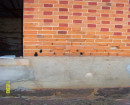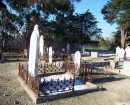Creswick Avenue of Honour and War Memorial
Creswick-Newstead Road,Creswick, HEPBURN SHIRE
-
Add to tour
You must log in to do that.
-
Share
-
Shortlist place
You must log in to do that.
- Download report
Statement of Significance
Nominator's Statement of Significance: The Creswick Avenue is neither as long nor as visually exciting as that at Ballarat. Nevertheless, this avenue makes a dominant landform feature in the low farming country. It is at the same time a poignant reminder of the emotions aroused by World War One. It carries, as few other elements in the shire do, a strong sense of the Imperial loyalties of the period. The choice of a growing avenue to mark the service of people in the shire itself suggests something of the sense of wartime achievements which must have inspired many in the shire well into the 1920s. It is a key visual reminder of the sentiments of a part of the local population during the 1920s. In a period in which the emotions aroused by the war are only recalled with difficulty, this site makes a powerful physical monument.
Significant Trees:
Ulmus x hollandica (Dutch Elm) for context: contribution to landscape, historical value: World War 1 x 285
-
-
Creswick Avenue of Honour and War Memorial - Physical Description 1
Avenue planted as a tribute to those who served in WW1. Ulmus x hollandica (Dutch Elm), height 16 m, 285 trees. A stone plaque reads: "Shire of Creswick Avenue of Honour a tribute to the men and women who served in the Great War 1914-1918.
Location: On either side of Creswick-Newstead Road, beginning approximately 500m north of junction with Midland Highway and continuing to township of Kingston; with some breaks the Avenue runs through the town itself to the northern limit of the buildings of Kingston. It is then continued towards Smeaton with apparently more recent plantings. The area considered here does not include the section within the town of Kingston or that running north to Kingston, since the uniformity of the design is abrogated on entering the town.
There are extensive evenly spaced plantings of exotic trees along the roadway. A memorial is situated on the east side of the roadway, 100m north of the present Kingston township. The avenue is a key landscape feature in the shire. The contrast between the evenly planted avenue and the flat farmland on either side gives a distinctive ambience to the site. As well the pattern of the avenue plantings are repeated in hedgerows along the boundaries of the road reservation.Creswick Avenue of Honour and War Memorial - Historical Australian Themes
Remembering the fallen
Creswick Avenue of Honour and War Memorial - Usage/Former Usage
Commemoration
Veterans Description for Public
Creswick Avenue of Honour and War Memorial - Veterans Description for Public
The Creswick Avenue of Honour was planted as a tribute to those who served in the First World War. Consisting of Ulmus x hollandica (Dutch Elm), the 285 trees are 16 meters in height. A stone plaque reads: "Shire of Creswick Avenue of Honour a tribute to the men and women who served in the Great War 1914-1918." Each tree originally bore a tablet with the name of a man or woman from the shire, but over the years some have faded or been erased. Graham's 'Early Creswick' contains an alphabetical listing of all those remembered in the avenue with the number of each tree originally bearing their individual names.
The Avenue is located on either side of Creswick-Newstead Road, beginning approximately 500m north of the junction with Midland Highway and continuing to the northern limit of Kingston (with some breaks). It is then continued towards Smeaton with apparently more recent plantings. The area considered here does not include the section within the town of Kingston or that running north to Kingston, since the uniformity of the design is abrogated on entering the town. There are extensive evenly spaced plantings of exotic trees along the roadway. A war memorial obelisk is situated on the east side of the roadway, 100m north of the present Kingston township.The avenue was opened on December 18th 1927 when Captain T. Parkin conducted a ceremony in which the obelisk was unveiled. The obelisk consists of Harcourt granite and was officially unveiled by Brigadier General Elliott, DSO. Elliot addressed his audience in familiar patriotic tones and stressed the continuing links between Australia and the United Kingdom.
In Australia, commemorative trees have been planted in public spaces since the late nineteenth century. Arbor Days were held regularly in most Victorian State Schools during the late 1800s and early 1900s, and numerous trees were planted in parks in Melbourne and throughout Victoria to mark the visits of important and famous people.
This tradition of commemorative planting was continued in 1901 when at the end of the Boer War trees were often planted for each soldier of the district who was killed in South Africa. These plantings, however, rarely consisted of more than two or three trees in each town.
During and after the First World War avenues of honour consisting of trees lining significant streets became a popular form of commemoration. They represented a new egalitarian approach to the commemoration of soldiers where rank was not a consideration: each tree symbolises a person.
Avenues of honour are a uniquely Australian phenomenon. Australians, and in particular Victorians, embraced the idea of planting them more enthusiastically than any other country in the world. The Eurack Avenue of Honour is the earliest known avenue of honour to be planted in Victoria and dates from May 1916.
By the time of the Second World War avenues of honour had declined in popularity as a means of commemoration. Today it is estimated that over 300 avenues of honour have been planted in Victoria to commemorate service personnel since 1901.
-
-
-
-
-
RAIL BRIDGE
 Victorian Heritage Register H1432
Victorian Heritage Register H1432 -
JUNCTION MINE
 Victorian Heritage Inventory
Victorian Heritage Inventory -
IMPERIAL MINE
 Victorian Heritage Inventory
Victorian Heritage Inventory
-
'YARROLA'
 Boroondara City
Boroondara City -
1 Bradford Avenue
 Boroondara City
Boroondara City
-
-










